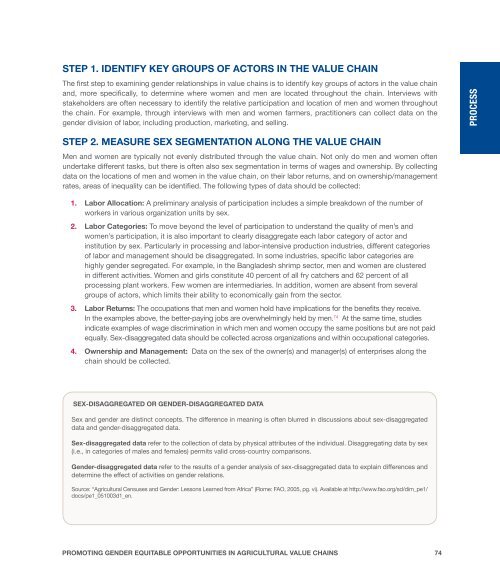promoting gender equitable opportunities in agricultural ... - weman
promoting gender equitable opportunities in agricultural ... - weman
promoting gender equitable opportunities in agricultural ... - weman
Create successful ePaper yourself
Turn your PDF publications into a flip-book with our unique Google optimized e-Paper software.
Step 1. Identify key groups of actors <strong>in</strong> the value cha<strong>in</strong>The first step to exam<strong>in</strong><strong>in</strong>g <strong>gender</strong> relationships <strong>in</strong> value cha<strong>in</strong>s is to identify key groups of actors <strong>in</strong> the value cha<strong>in</strong>and, more specifically, to determ<strong>in</strong>e where women and men are located throughout the cha<strong>in</strong>. Interviews withstakeholders are often necessary to identify the relative participation and location of men and women throughoutthe cha<strong>in</strong>. For example, through <strong>in</strong>terviews with men and women farmers, practitioners can collect data on the<strong>gender</strong> division of labor, <strong>in</strong>clud<strong>in</strong>g production, market<strong>in</strong>g, and sell<strong>in</strong>g.ProcessStep 2. Measure sex segmentation along the value cha<strong>in</strong>Men and women are typically not evenly distributed through the value cha<strong>in</strong>. Not only do men and women oftenundertake different tasks, but there is often also sex segmentation <strong>in</strong> terms of wages and ownership. By collect<strong>in</strong>gdata on the locations of men and women <strong>in</strong> the value cha<strong>in</strong>, on their labor returns, and on ownership/managementrates, areas of <strong>in</strong>equality can be identified. The follow<strong>in</strong>g types of data should be collected:1. Labor Allocation: A prelim<strong>in</strong>ary analysis of participation <strong>in</strong>cludes a simple breakdown of the number ofworkers <strong>in</strong> various organization units by sex.2. Labor Categories: To move beyond the level of participation to understand the quality of men’s andwomen’s participation, it is also important to clearly disaggregate each labor category of actor and<strong>in</strong>stitution by sex. Particularly <strong>in</strong> process<strong>in</strong>g and labor-<strong>in</strong>tensive production <strong>in</strong>dustries, different categoriesof labor and management should be disaggregated. In some <strong>in</strong>dustries, specific labor categories arehighly <strong>gender</strong> segregated. For example, <strong>in</strong> the Bangladesh shrimp sector, men and women are clustered<strong>in</strong> different activities. Women and girls constitute 40 percent of all fry catchers and 62 percent of allprocess<strong>in</strong>g plant workers. Few women are <strong>in</strong>termediaries. In addition, women are absent from severalgroups of actors, which limits their ability to economically ga<strong>in</strong> from the sector.3. Labor Returns: The occupations that men and women hold have implications for the benefits they receive.In the examples above, the better-pay<strong>in</strong>g jobs are overwhelm<strong>in</strong>gly held by men. 74 At the same time, studies<strong>in</strong>dicate examples of wage discrim<strong>in</strong>ation <strong>in</strong> which men and women occupy the same positions but are not paidequally. Sex-disaggregated data should be collected across organizations and with<strong>in</strong> occupational categories.4. Ownership and Management: Data on the sex of the owner(s) and manager(s) of enterprises along thecha<strong>in</strong> should be collected.SEX-DISAGGREGATED OR GENDER-DISAGGREGATED DATASex and <strong>gender</strong> are dist<strong>in</strong>ct concepts. The difference <strong>in</strong> mean<strong>in</strong>g is often blurred <strong>in</strong> discussions about sex-disaggregateddata and <strong>gender</strong>-disaggregated data.Sex-disaggregated data refer to the collection of data by physical attributes of the <strong>in</strong>dividual. Disaggregat<strong>in</strong>g data by sex(i.e., <strong>in</strong> categories of males and females) permits valid cross-country comparisons.Gender-disaggregated data refer to the results of a <strong>gender</strong> analysis of sex-disaggregated data to expla<strong>in</strong> differences anddeterm<strong>in</strong>e the effect of activities on <strong>gender</strong> relations.Source: “Agricultural Censuses and Gender: Lessons Learned from Africa” (Rome: FAO, 2005, pg. vi). Available at http://www.fao.org/sd/dim_pe1/docs/pe1_051003d1_en.PROMOTING GENDER EQUITABLE OPPORTUNITIES IN AGRICULTURAL VALUE CHAINS 74










